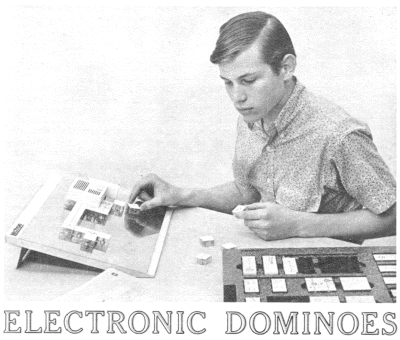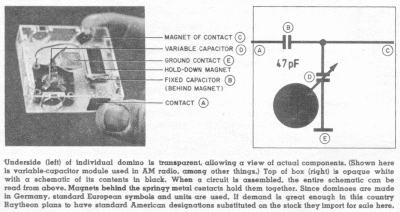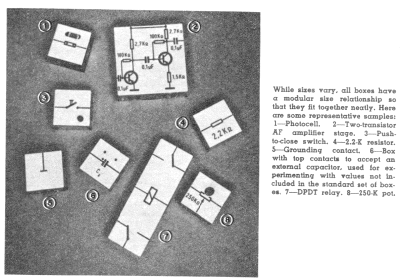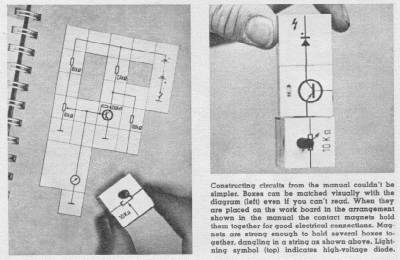Monday, January 31, 2011
A half century of kids playing with Circuitry
 |
| Add caption |
A toy, similar to "Snap Circuits "
" was covered in the September 1967 issue of Electronics Illustrated. Then and now what you get is a box of domino like magnetic pieces that allow kids to snap together such cool items as a radio, a light activated multi-vibrator, a voice activated switch, a solar panel, a burglar alarm and many more. The toymaker today is Elenco Electronics but originally it turns out it was Raytheon, the inventor of radar and the fifth largest military contractor in the world. Revenues of 25,000 billion, employing 75,000 today. An article by Emer Carlson about the 1960's product is below. This toy is equally fascinating today. (Thanks for the link Hal!)
was covered in the September 1967 issue of Electronics Illustrated. Then and now what you get is a box of domino like magnetic pieces that allow kids to snap together such cool items as a radio, a light activated multi-vibrator, a voice activated switch, a solar panel, a burglar alarm and many more. The toymaker today is Elenco Electronics but originally it turns out it was Raytheon, the inventor of radar and the fifth largest military contractor in the world. Revenues of 25,000 billion, employing 75,000 today. An article by Emer Carlson about the 1960's product is below. This toy is equally fascinating today. (Thanks for the link Hal!)
Instant is the word of the jet age. Time grows more valuable every day. Once we spent six days in leisure travel from New York to California by train. Now we can't wait for a supersonic jet to get us there before we leave. And so it is with electronics. There's a mountain of information to learn in what always turns out to be too little time.
To help grease the skids of learning basic electronics and get your hands into practical working circuits, there's a new kit of domino-like plastic electronic boxes. Now, this isn't just an electronic game. It's the way to instant learning.
Big drag when studying electronics is putting circuits together. It's time-consuming to cut and twist component leads, connect them, solder them, support them and keep them from shorting. You have enough to do just learning how a circuit operates. And then think of the mess when you take everything apart for another experiment. Solder drippings, burned finger, broken leads, sloppy layouts, heat-damaged semiconductors - all of this makes you wish you'd never started.
But now it can be as much fun to put electronic circuits together and to learn fundamentals as it is to put words together when you play Scrabble. The Egger-Lectron Model 8400 learning aid is imported from Germany and will be distributed by the Macalaster Scientific Co. (a subsidiary of Raytheon), 186 Third Ave., Waltham, Mass., 02154. In this country they will be called electronic dominoes.
Just about anyone can put together an operating circuit as easily as they could play real dominoes. Each of the plastic boxes contains one or more electronic components or an interconnecting part. The kit supplied to us by Raytheon contains a carefully-selected collection of components, all neatly done up in plastic boxes bearing a schematic symbol of the contents, a manual of experiments and two work boards. Even a 9-year-old child can match the marked dominoes with those on the schematics to build and demonstrate a light meter, electronic thermometer, tone generator or radio - to mention a few of the 90 experiments in the manual that accompanies the complete set. For the high school student, there are more advanced projects such as a three-transistor reflex-AM radio, metering circuits, transistor-testers and simple computer flip-flops.
The three-transistor reflex-AM radio and several smaller circuits were put together in about an hour the first evening we worked with the set. And that included time for experimenting - which is at least half the fun of building the circuits. Of course, if you want to snap the boxes together really fast, give the circuit a quick test, then pull it apart and snap together another circuit. You could do eight or ten circuits in an hour.
The set we show here contains 108 plastic boxes. Sixty-five contain such components as resistors, capacitors, transistors (with and without a bias resistor), a meter, a relay, a thermistor, potentiometers, rheostats, RF transformer, speaker, push-button switches, diodes, variable capacitor, photocell and battery packs. Eight are blanks in which there are small contacts that accept the leads of resistors, capacitors, inductors or transistors for supplying values not included in the set. Jacked boxes will accept special inputs or test leads, for example. Other boxes contain connectors to join boxes to boxes or to ground a component to the work board.
How Does It All Work? In vaudeville they used to say it was all done with mirrors. In Dominoes it's all done with magnets. Instead of using clips, binding posts, or springs to hold parts together, each box is equipped with small magnets at the pointswhere it is ot contact another box or the board. The sides and the bottom of each box are made of clear plastic so you can see what's inside. The top of each box - carrying the schematic symbol - is opaque white.
Some of the circuits can, incidentally, be a little touchy. Squeeze a little here, apply some pressure there and suddenly the circuit works like a charm - a light blinks, the meter needle moves or the speaker sounds. The longer we used the set, however, the less we seemed to have contact problems.
The work surface of each of the 13 x 15-1/2 inch work boards is covered with a plated ferrous metal sheet forming the ground or common connection for all the circuits, just like a radio chassis. Since two battery boxes and two work boards were included in the set, it is possible to put together two circuits at the same time - provided you don't have too many components in each circuits. The concept has great potential as a teaching tool. In only a few seconds it is possible to set up a practical circuit that would only be schematic symbols in a textbook. The work boards can be propped up on their built-in stands or hung on the wall so that a whole classroom can see the demonstration. Componenets in any circuit can be changed instantly to show their effect on circuit performance. Special experiments in the manual demonstrate the characteristics of components - resisitance, inductance and capacitance; how tuned circuits affect radio reception; effects of base current on emitter-collector current flow and other electronic principles.
Okay, let's open the manual and see what we can learn. Believe it or not, the first experiment is a multivibrator flasher made with 21 boxes. Now this is hardly the sort of experiment and the 19 that follow is simply to give you a taste of some of the interesting things to come.
Experiment No. 21 is about as simple as you could want. It consists of a bulb, battery and switch in series. This is basic. In the next two experiments you put resistors in series with battery and lamp to note the effect of adding resistance in the circuit. The lamp, of course, gets dimmer. From there the experiments go on through multivibrators, audio, photocell applications, relays, etc., ending with a burglar alarm.
Everybody who has seem the dominoes has found it hard to keep his hands off them. Their arrival in our New York office threatened to play havoc with production schedules, in fact, until some killjoy remembered that they had been designed for kids. So we sheepishly carted them off to a household that included a bright 14-year-old. He was delighted.
Frist project on the agenda was, of course, the AM radio circuit - even though that's toward the back of the book. It worked and he was hooked. He and his father (who was also hooked by this time) were having a grand time trying circuit after circuit when the eight-year-old kid sister showed up and wanted to play, too. Now this is not quite cricket, according to Raytheon, because the dominoes are geared to high-school instruction. Nothing daunted, she abandoned her numbered painting and pitched in.
It's a good thing that battery packs and work boards supplied in pairs in the set they were using. Otherwise we would have been responsible for introducing dissention into a happy home. As it was, both kids ended up pushing Dad aside and going their, merry, electronic ways. Numbered painting? Who needs it?
Next of the priviledged junior set to get his grubby little hands on the dominoes was a five-year-old. Now we were really on unspoiled ground since this boy had never even heard of a circuit. We tried experiment No. 21. The chocolate-smeared finger gleefully pushed the button of the push-to-close switch while the bulb flashed on and off. Fine - audience participation! But what was he getting out of it, we wondered. Next he wanted to see the meter work so we set up the battery-tester circuit with the same push-to-close switch. More delight.
The experience of a five-year-old can't be expected to add up to a hill of beans, electronically speaking. But it does demonstrate the appeal of the dominoes. It's hard to imagine any other means by which you could get across these basic concepts so quickly and so vividly. The fact that kids can put the parts in place themselves and see immediate results from their efforts beats fussing with Fahnestock clips and interconnecting wires all hollow - to say nothing of messing with soldering irons.
All this is fine in the school. Homebodies may have reservations about the cost, however. A basic starter kit, the Mini Lectron, having pretty limited capabilities, is expected to sell for $19.50. While the way will be eased to biffer and better things by the availability of individual blister-packed add-on units, cost of a full set like the one we had will probably be $128. Two intermediate sets are also planned.
Still, considering the way the Lectron can put across ideas (even to our five-year-old, who corrected a mistake of his father's after only ten minutes with the darn thing), it's got to be one of the grandest educational toys, ever. -Elmer Carlson
Subscribe to:
Comments (Atom)



